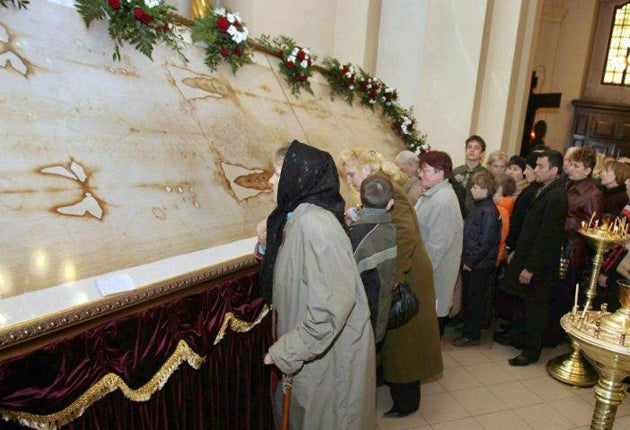Turin Shroud expected to attract two million visitors
World's most famous holy relic on display for only sixth time in a century

Your support helps us to tell the story
From reproductive rights to climate change to Big Tech, The Independent is on the ground when the story is developing. Whether it's investigating the financials of Elon Musk's pro-Trump PAC or producing our latest documentary, 'The A Word', which shines a light on the American women fighting for reproductive rights, we know how important it is to parse out the facts from the messaging.
At such a critical moment in US history, we need reporters on the ground. Your donation allows us to keep sending journalists to speak to both sides of the story.
The Independent is trusted by Americans across the entire political spectrum. And unlike many other quality news outlets, we choose not to lock Americans out of our reporting and analysis with paywalls. We believe quality journalism should be available to everyone, paid for by those who can afford it.
Your support makes all the difference.The face of Christ or a brilliant hoax? More than two million of the faithful, undecided or merely curious who are expected to converge on Turin Cathedral this spring will be able to decide for themselves when the most famous religious relic in the world goes on display for only the sixth time in 100 years.
The public viewing of the Turin Shroud, the cloth that some say bears the imprint of Jesus's face after his crucifixion, will be the first since a painstaking restoration was completed in 2002.
Fiorenzo Alfieri, Turin's councillor for culture, said this week that around one million people have already ordered tickets to see the relic, which will be on display in its bulletproof, climate-controlled case from 10 April to 23 May. Mr Alfieri expected more than two million visitors from around the globe.
Traditionally, the public is allowed to see the shroud every 25 years, but church officials have said they understand its "importance to the economy and employment" of the northern Italian city – hence their decision to allow the latest public display just 10 years after the last one.
Whether the most-studied artifact in human history really does bear the image of Christ or merely the skilled work of medieval pranksters has been the source of debate for centuries, however. The cloth bears the faint image of the front and back of a tall, long-haired, bearded man and appears to be stained by blood of wounds indicative of crucifixion.
Independent carbon-dating tests done in 1988 by researchers at Oxford, Zurich and Tucson, Arizona, estimated that the Shroud was made between 1260 and 1390, suggesting it was a hoax.
But some scientists have argued that contamination over the ages may have skewed the results.
One Vatican researcher claims to have found faint traces of script in Aramaic, ancient Greek and Latin on the shroud, while two Israeli scientists said plant pollen found on the cloth supported the view that it comes from the Holy Land.
In 2005, a study, published in the scientific journal Thermonautica Acta, claimed that the Shroud was between 1,300 and 3,000 years old.
In addition, people who believe in the relic's authenticity say that scientists have never been able to adequately explain how the shroud's image was made. Monsignor Giuseppe Ghiberti, president of the Turin archdiocese's commission on the Shroud, said the Vatican might consider a new round of scientific tests after the public display ends, given recent developments in the field of carbon-dating.
But in April and May visitors will be able to decide for themselves if the Shroud appears realistic. Viewing – a maximum of five minutes a person – is free by reservation, which can be made online.
Pope Benedict XVI is expected to visit the shroud on 2 May. The Vatican itself has carefully avoided opining on the Shroud's authenticity but has instead described it as "a powerful symbol of Christ's suffering".
It is thought that the Shroud travelled widely before it was brought to France in the 14th century by a crusader. Nuns subsequently looked after it before it was given to the Turin archbishop in 1578 by the Duke of Savoy. The relic was then bequeathed to the Pope by former King Umberto II of Italy, upon his death in 1983.
Join our commenting forum
Join thought-provoking conversations, follow other Independent readers and see their replies
Comments